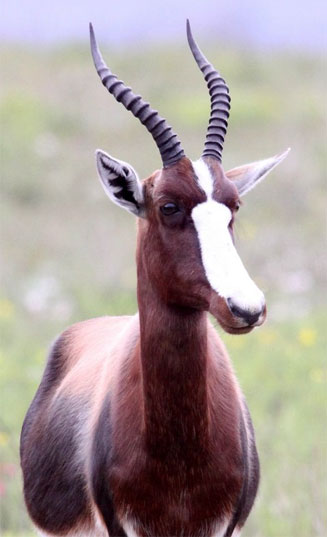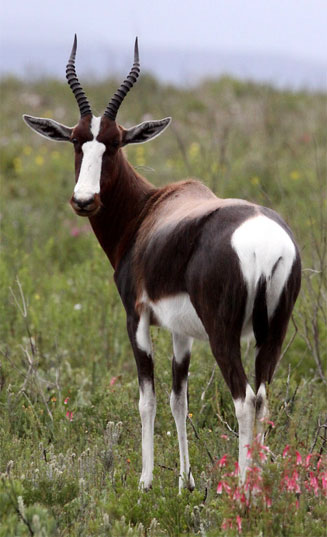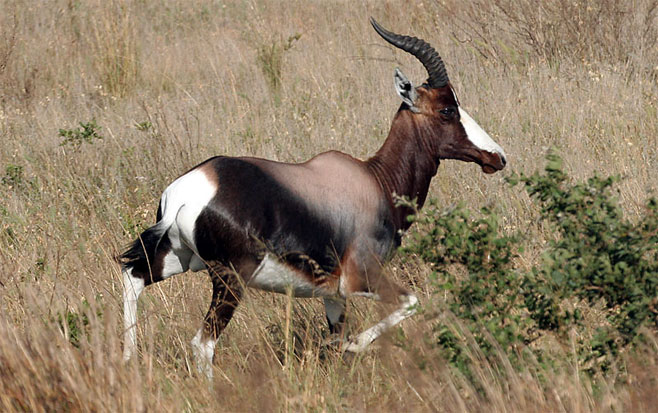|
Damaliscus pygargus pygargus (Bontebok)
bontebok [Afrikaans]; Buntbock [German]; bontebok [French]; pitsi ya
maronthonthwane [Sepedi]; inyamatane [siSwati]; nglangu [Xitsonga]
Life
>
Eukaryotes >
Opisthokonta >
Metazoa (animals) > Bilateria > Deuterostomia >
Chordata > Craniata > Vertebrata (vertebrates) >
Gnathostomata (jawed vertebrates) > Teleostomi (teleost
fish) > Osteichthyes (bony fish) > Class:
Sarcopterygii (lobe-finned fish) > Stegocephalia
(terrestrial vertebrates) > Reptiliomorpha > Amniota >
Synapsida (mammal-like reptiles) > Therapsida > Theriodontia
> Cynodontia > Mammalia (mammals)
> Placentalia (placental mammals) >
Laurasiatheria > Ferungulata > Cetartiodactyla (even-toed ungulates and cetaceans)
> Ruminantia (ruminants) > Family:
Bovidae (antelopes and buffalo) > Subfamily: Antilopinae
 |
 |
|
Bontebok, Bontebok National Park, South Africa.. [photos Coke
Smith
©] |
 |
|
Bontebok, Bontebok National Park, South Africa.. [photo Jim Scarff ©] |
This subspecies of Damaliscus pygargus is
endemic to the fynbos with its original distribution lying on the
fynbos plains from the Agulhas plain through to about Mossel
Bay. It was once near extinction but is well-protected now. Social
structure consists of territorial males, female herds and bachelor
herds. They graze mainly on short grass but also occasionally
browse.
Identification
Bontebok is a medium sized antelope similar in body shape
to the other hartebeests and the Tsessebe. They have long pointed heads with
lyre shaped horns and the shoulder is higher than the rump. Bontebok have a rich
glossy dark brown body colour, they are darker on the flanks and upper parts of
the limbs. The distinctive white blaze on their face is usually continuous
(unlike the Blesbok, which is
regarded as the same species but a different subspecies) narrowing between the
eyes. The limbs and the rump are white. The ears are a slightly lighter brown
than the rest of the body. The tail is white for about half its length, the
remainder being dark brown with long black hair on the tip. Both sexes have
black horns that are ringed on the upper surface, the ewe’s are more slender
than the ram. Preorbital glands are present in both sexes but well-developed in
the male. They exude a sticky secretion that makes tear marks down the animals
face. Territorial rams apply this secretion to grass stems and also appear to
transfer it back to their horns from the grass.
Size
Height at shoulder 95 cm; horn length 31 cm; weight
70 kg (male) and 60 kg (female)
Dental formula
I
 C C P P M M =
32 =
32
Distribution and habitat
Historical distribution was restricted to Bredasdorp and
Mossel Bay areas of the Western Cape. Now conserved on several reserves and
private farms in the Western Cape. Its preferred habitat is Cape fynbos coastal
plain vegetation with grass, water and some shrub cover.
General behaviour
They are active during the day (diurnal), but activity
levels do drop during the hotter parts of the day. During the heat of the day
bontebok herds characteristically orientate themselves towards the sun with
their heads bowed. The social structure consists of territorial males, female
herds and bachelor groups. The territorial males establish and hold a mosaic of
territories, and they challenge intruders by displays to show their dominance.
Serious fighting between males is rare but challenging males may engage in fierce
pushing contests where they drop to their knees with their foreheads close to
the ground and push and feint at each other, occasionally clashing or locking
horns. These mostly ritualized encounters are usually short and the loser with
give up and move off. The males try to hold females within their territories by
courting them. Female herds consist of a maximum of about 8 animals,
composed of females and their young. Bachelor herds are much larger and looser
groupings consisting of males of all ages from yearlings to old males. While
they do move through territorial male areas they normally avoid any challenges
and simply move on.
Food
Bontebok are grazers with a preference for shorter grass,
but will occasionally browse.
Reproduction
Gestation period is about 240 days. Bontebok lambs are born
during September – October although some may be dropped as late as February.
Usually single lambs are born but occasionally twins. At birth the lambs are
pale beige to cream in colour and can run with their mother within 30 minutes of
birth. Young males leave their mother after a year when the next offspring is
born, but females will remain with their mothers as members of the herd. Life
span: 15 years (in captivity)
Conservation
This subspecies is endemic to the Western Cape and the
fynbos biome. After near extinction the first steps of its conservation were
taken in 1837 with a nucleus of 27 animals on a private farm. In 1931 the first
Bontebok National Park was proclaimed, but in 1961, 84 bontebok were moved to a
new and more suitable site near Swellendam. Further successful conservation on
private farms and conservancies has resulted in a current population estimated
at around 2300 animals. Their conservation status is listed as vulnerable, and
their continued existence is dependent on effective protection and conservation.
As they can cross breed with Blesbok
it is important that the populations of the two subspecies are isolated from
each other for effective conservation.
Text by Denise Hamerton
|
